September 2021
A Review of Trotsky in New York 1917
“Bronx Man Leads Russian Revolution”
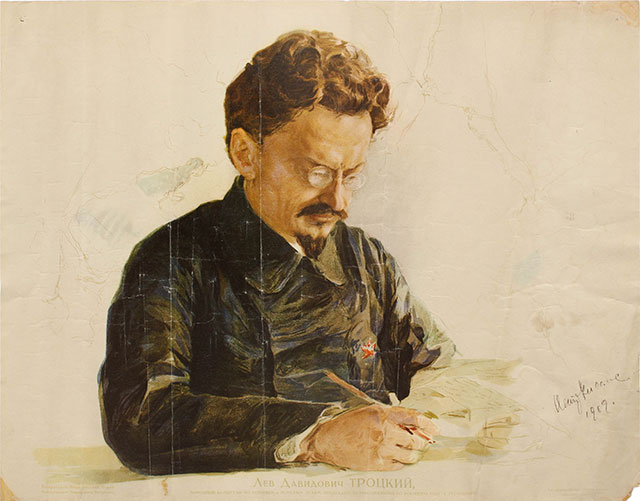
Early Soviet poster of Leon Trotsky.
By Jacob
“Bronx Man Leads Russian Revolution,” read the headline of the Bronx Home News. “Trotsky, Now In Kerensky’s Place, Once Lived Here,” added the New York World four days after the Bolshevik Party led the working class to power in the world’s first victorious socialist revolution, the Russian Revolution of 7 November 1917.1 Across the world the names of V.I. Lenin and Leon Trotsky became synonyms and symbols of the aspirations of the exploited and oppressed. But few people today realize that just months before becoming the principal organizer of the Bolshevik victory, and then founder of the Red Army, Leon Trotsky had been living here in New York City, uptown in the Bronx.
For years, fantastical rumors circulated that during his time in New York Trotsky had worked as a tailor, a dishwasher, even a film actor. Laying these legends to rest in his autobiography My Life (1930), Trotsky explained:
“In New York, where I stayed for two months, the newspapers had me engaged in any number of occupations, each more fantastic than the one before…. But I must disappoint my American readers. My only profession in New York was that of a revolutionary socialist.”
The obscure story of Trotsky’s brief stay in New York in early 1917 is of special interest to students at the City University of New York. For members of the CUNY Internationalist Clubs, which were forged in the midst of campaigns against the U.S. imperialist wars in Afghanistan and Iraq, the story of Trotsky’s efforts to mobilize the working class against World War I in this very city a century ago, in meetings and public actions that took place often a short train ride away from our schools, is a fascinating reminder of the historical continuity of our movement.
Kenneth D. Ackerman’s cinematically written Trotsky In New York 1917: A Radical On the Eve of Revolution (2016) gives a definitive account of the Russian revolutionary’s Bronx exile. Ackerman uncovers the history of Trotsky’s little-known intervention into the politics of the Socialist Party of America (SP), guiding us through New York’s radical landmarks as he recounts the impassioned debates. Central to these was Trotsky’s overlooked showdown with Morris Hillquit, the SP’s NYC-based reformist party boss.
Above all, Trotsky In New York makes an important historical point: during his ten weeks in New York City, Trotsky’s struggle for revolutionary internationalism, against the reformists, helped pave the way for the birth of the American Communist movement, which changed the landscape of the U.S. left for generations. More broadly, it is part of the prehistory of the Communist (Third) International, formed at the Bolsheviks’ initiative after the old Socialist (Second) International blew apart when its parties in most of the warring countries supported their “own” rulers against the workers on the other side of the trenches.
Revolutionaries vs. Reformists
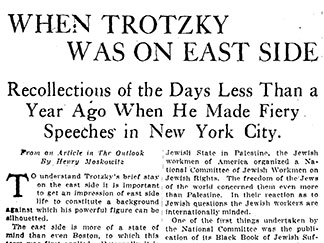 New York Times (10
February 1918), three months after the Bolshevik
Revolution.
New York Times (10
February 1918), three months after the Bolshevik
Revolution.Following the outbreak of World War I, Trotsky was expelled from country after country for his revolutionary activity against the imperialist slaughter that would take the lives of millions. Already banished from Russia for his leading role in the 1905 Revolution as chairman of the St. Petersburg soviet (workers council), Trotsky narrowly avoided arrest in Austria and was deported from France, then Spain, before finally arriving in New York Harbor aboard the Monserrat.
“Leon Trotsky Is Arriving Today!” the New Yorker Volkszeitung proclaimed on 14 January 1917, urging its fourteen thousand readers to greet “our much persecuted comrade” and “courageous fellow combatant.” “In Comrade Trotsky,” wrote the Russian Novy Mir that same day, “America gains a resolute fighter for the Revolutionary International.”2
Trotsky was well-received by New York City’s largely Eastern European and German socialist milieu. Tsarist repression and anti-Semitic pogromist violence had also brought hundreds of thousands of immigrants from the Russian Empire, mostly Jews, to New York City, where they mainly settled on Manhattan’s Lower East Side. Many had, like Trotsky, been part of the failed Revolution of 1905. It was here amidst the garment sweatshops and tenements that the “Uprising of 20,000” – mass strikes of young immigrant women garment workers in 1909-10, followed by the Triangle Shirtwaist Fire – occurred and International Women’s Day arose. In fact, women workers’ protests on that international proletarian holiday were what would soon touch off a new revolution in Russia, on 8 March 1917.3
Emblematic of the size of the immigrant socialist movement in New York was the then-leftist Yiddish-language daily Forverts (Forward), whose circulation of over 200,000 rivaled that of the New York Times. To this day, the Forward building, with its portraits of Karl Marx and Friedrich Engels (as well as 19th-century German socialist leaders August Bebel and Ferdinand Lasalle), still stands on East Broadway. But in typical present-day New York City fashion, it now houses luxury condos.
Disembarking the Monserrat on a cold, rainy Sunday morning, Trotsky, his companion Natalia Sedova and their two sons were greeted by friends and political associates who had also managed to escape tsarist persecution, and a flock of journalists from New York City’s numerous socialist publications. Among those who greeted him was Bolshevik leader Nikolai Bukharin, who famously insisted that Trotsky immediately visit the New York Public Library on 42nd Street.4 Within days he would settle in the Bronx, at 1522 Vyse Avenue near Crotona Park.
Even the bourgeois press noted Trotsky’s arrival, though their coverage mischaracterized as “pacifism” his call for mass working-class action against the imperialist war.5 The New York Times (15 January 1917) headlined that Trotsky had been “Expelled From Four Lands” (“With Bayonets,” added the New York Tribune). Within two days, his arrival would be covered by six New York papers, with a combined readership of more than half a million.
For his part, on the day after his arrival Trotsky jumped headfirst into New York socialist politics. He began work for the Novy Mir, whose offices were located in the basement of 77 St. Mark’s Place near First Ave., just a block away from Tompkins Square Park. Trotsky later described Novy Mir as a “headquarters for internationalist revolutionary propaganda.” There his articles would appear alongside those of others including Bukharin; Alexandra Kollontai, best known for her powerful articles and speeches on the Marxist program for women’s liberation through socialist revolution;6 Grigory Chudnovsky, who as a Red Guard participated in the seizure of the Winter Palace described in John Reed’s classic first-hand account of the Bolshevik Revolution, Ten Days That Shook the World; and V. Volodarsky, who became Petrograd’s press commissar after the Revolution. (This joint work with Bolsheviks in New York presaged Trotsky joining the Bolshevik Party after his return to Russia.) On January 15, the Forverts sent a journalist to cover Trotsky’s first day in New York, publishing a front-page headline and a photo of Trotsky standing on St. Mark’s.
On his second night in New York, Trotsky attended a meeting at the home of New Yorker Volkszeitung editor Ludwig Lore, on 55th Street in Brooklyn. The objective: to work out a “program of action for Socialists of the Left, for the purpose of organizing the radical forces in the American Socialist movement.”7 Participants came from the internationalist wing of the socialist movement that opposed the ongoing world war. Among the guests were Bukharin and Kollontai as well as Sen Katayama, the founder of Japanese socialism who had famously embraced Russian Marxist pioneer Georgi Plekhanov at the 1904 congress of the Socialist International to symbolize international workers solidarity amidst the Russo-Japanese War.
In the thick of things at the meeting was Louis Fraina, the Italian immigrant radical who soon became editor of a paper called The Internationalist. Published by the Socialist Propaganda League, founded in a Latvian workers’ hall a few months previously, Lenin read it from Switzerland and held it in high regard. Also present was Louis Boudin, a labor lawyer and author of one of the most influential books in the early U.S. Marxist movement, The Theoretical System of Karl Marx (1907).8
The main topic of discussion at the meeting on that evening in mid-June of 1917 (which Ackerman describes as a dinner party) was the brewing fight against the opportunist Socialist Party leadership under Morris Hillquit.
Faction Struggle in the Socialist Party
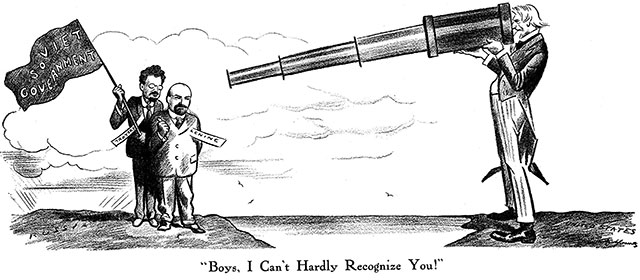
Cartoon in left-wing New York magazine Liberator (July 1918) on the U.S. refusal to “recognize” the Bolshevik government of Lenin and Trotsky.
(Photo: The Liberator)
Among his many electoral campaigns as a Socialist Party candidate, Hillquit’s 1917 New York mayoral campaign struck an antiwar note. Together with opposition to escalating attacks on civil liberties – like Woodrow Wilson’s vicious Espionage Act – this drew considerable support among radical workers; Hillquit got a fifth of the vote. Nonetheless, Hillquit was a staunch reformist. In her diary, Kollontai called him “a vile revisionist.” Trotsky later described him in My Life as “the ideal Socialist leader for successful dentists.”
In 1912, Hillquit had orchestrated the expulsion from the SP’s leading body of the class-struggle hero and Industrial Workers of the World leader “Big Bill” Haywood, for advocating the use of militant tactics in labor struggles.9 This set the pattern for the stance Hillquit took on the war in deeds (as opposed to just words). He was part of a January 1916 delegation to the White House asking President Wilson to please keep the U.S. out of World War I but he promised that should the U.S. enter the conflict, socialists would comply with the war effort. In November 1916, the Jim Crow Democrat Wilson was reelected to the presidency on the slogan “He Kept Us Out of War.” Hillquit, no dummy, knew Wilson’s words were hokum to hook voters; war was coming for the workers of the U.S. too. So the SP leader announced to the New York Times (11 February 1917): “I do not believe that the Socialists will advocate any general industrial strike to handicap the country in its war preparations. And I do not believe there will be any such strike.”
And of course, the “peace-loving” imperialist Wilson would indeed soon take the U.S. into what he called the “war to end all wars” and “make the world safe for democracy.” The real purpose: to uphold, consolidate and expand the power of U.S. imperialism, which had seized Puerto Rico and the Philippines two decades previously, lorded it over Cuba and Central America; had made billions of dollars in war loans to France and Britain; and was well on its way to replacing the latter as the dominant power worldwide.
In contrast to reformists like Hillquit & Co., the leftists wanted workers action against the imperialist war. In the words of Rosa Luxemburg’s comrade Karl Liebknecht in Germany, “the main enemy is at home”; the burning need was to “turn the imperialist war into a civil war” of the exploited against their exploiters, putting an end to the slaughter through socialist revolution. The fight in the American SP was a reflection of the great issues facing the socialist movement worldwide. So at the 15 January 1917 meeting at Ludwig Lore’s home in Brooklyn, by the end of the evening, a formal vote was taken. Katayama wrote later: “We intended to organize the Left Wing under the direction of Comrade Trotzky, and Madam Kollontai, who was going to Europe, was to establish a link between the European and American Left Wing movements.”10
While joining the struggle against the reformist SP leaders and contributing articles to socialist publications, Trotsky was addressing large crowds at public meetings in venues across the city such as the Brooklyn Lyceum, Beethoven Hall in Manhattan, the Labor Temple near Union Square and the Great Hall of Cooper Union, calling for international working-class solidarity and continued class struggle. “Trotsky built up a large and enthusiastic personal following,” Ludwig Lore later wrote. In his spare time, he studied at the Public Library on 42nd Street and took meals at the Monopoly Café on 2nd Avenue.
His first political clash in New York took place when on March 1, the Forverts published a patriotic headline article promising that “every inhabitant of the country would fight to the last drop of blood” should war break out with Germany. According to one account, Trotsky marched over from the Novy Mir offices to the Forward building, stormed into the office of its editor Abraham Cahan, and denounced him for being a “social-patriot,” a socialist in words, but a patriotic defender of imperialism in deeds.
As a result of his growing influence, Trotsky was brought onto the Resolutions Committee of the New York Socialist Party alongside his new friend Louis Fraina and adversary Morris Hillquit. Trotsky and Fraina demanded that the Socialist Party unequivocally oppose the war and inevitable U.S. entry. They penned and put forward a resolution rejecting “national defense,” condemning party members who made patriotic promises in the bourgeois press (a clear shot at Hillquit), and calling for mass labor action to oppose U.S. entry into the war. The resolution ended with the call: “No ‘civil peace’! No truce with the ruling class! War does not change the issue, but emphasizes it. War against capitalism! On with the class struggle!”
Hillquit and his associates claimed they were willing to concede on the first two points, but refused to align the Socialist Party against the capitalist state by calling for mass labor action to stop war preparations. Since the committee reached an impasse, and Trotsky and Fraina refused to compromise their principles to reach a deal with the reformists, a general meeting was called for the following Sunday, March 4.
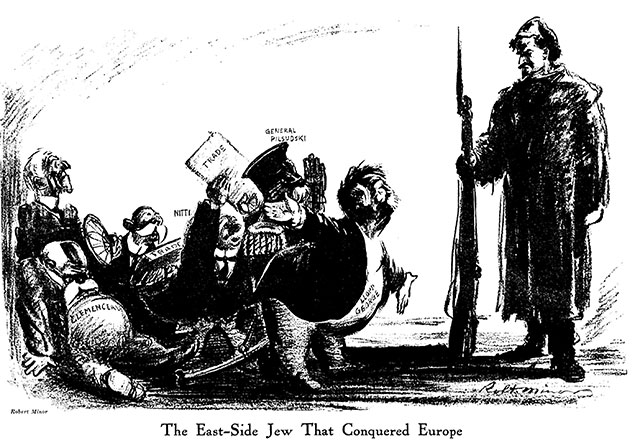
Trotsky’s Red Army routed capitalist powers’ intervention against the Revolution. Liberator (March 1920) cartoon, proud of Trotsky’s time in NYC, derides anti-Bolshevik propagandists’ use of anti-Semitism. (Photo: The Liberator)
One hundred eight members of the party gathered at the Lenox Casino in Harlem, a site which decades later became home to Mosque No. 7, where Malcolm X preached for the Nation of Islam. Fraina delivered the Resolutions Committee minority report that he had written with Trotsky calling for class struggle against imperialist war. Hillquit, ever the parliamentary maneuverist, tried to table the report and prevent Fraina from putting forward the perspective of the left-wing opposition. When the crowd became outraged, Hillquit withdrew his motion. Heated debate unfolded.
Only one later account of this face-off specifically mentions Trotsky; Ackerman notes that he was scheduled to speak in Newark at the same time. But Louis Waldman, a prominent figure in Hillquit’s crew, recalled that after speaking at the Lenox Casino SP meeting, “as I sat down, Trotsky, who was sitting in front of me, turned and sneered: ‘Chauvinist!’” In the end, after a vote was called, the Trotsky-Fraina report was defeated, by a vote of 101 to 79.
Yet the internationalist left wing of the Socialist Party did not abandon its struggle. Plans were made to continue rallying workers in solidarity with their brothers and sisters in the belligerent imperialist powers, and to launch an organ titled The Class Struggle to be edited by Boudin and Trotsky, with significant contribution from Fraina and Lore. Though The Class Struggle's first issue would come out in May 1917, with articles by Fraina on “The War and America,” by Boudin on the SP’s emergency convention (held in St. Louis in April, its keynote address was given by Hillquit), and by Bukharin on the revolutionary struggle in Russia, by that time the events had taken a huge new turn.
Internment and Internationalism
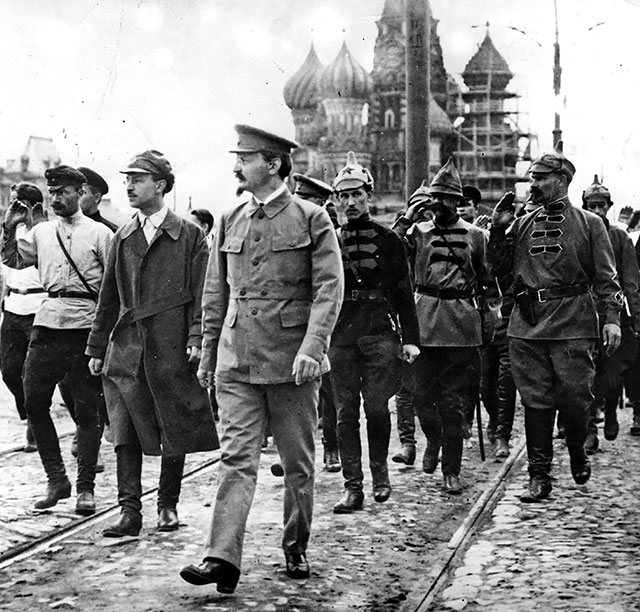
People’s Commissar for Military and Naval Affairs: Leon Trotsky in Moscow’s Red Square circa 1920.
(Photo: Getty Images)
On 8 March 1917, International Women’s Day, Leon Trotsky was addressing a crowd from the podium of the Great Hall of Cooper Union, sharing the podium with Socialist Party icon Eugene Debs, who was later jailed for his opposition to World War. (Declaring solidarity with Lenin, Trotsky, and the Russian Revolution, though he was unable to make the transition to Bolshevism himself, Debs famously ran for president from his prison cell in 1920.)11
On that same day, the protests broke out in Russia that within days would topple the 300-year-old Romanov dynasty and end monarchist rule. The revolution had begun. With the March upheaval (called the “February Revolution” due to the dates of the old Russian calendar), the workers soviets that arose in 1905 emerged once more, leading to a situation of “dual power.” Yet the reformist leaders who for the time being dominated the soviets were political brethren of class-collaborationists like Hillquit and the French and German pro-war “socialists”; they joined the unelected bourgeois Provisional Government of Alexander Kerensky. Denouncing any kind of confidence in or political support to the new, bourgeois “democratic” regime, Lenin called for “All Power to the Soviets!” This set the stage for Russia’s October Revolution, which Trotsky would lead together with him.
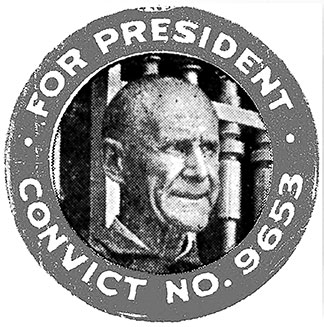 Convicted for speech against
WWI, Eugene V. Debs ran for president from his prison cell
in 1920.
Convicted for speech against
WWI, Eugene V. Debs ran for president from his prison cell
in 1920.Burning to get back to Russia, Trotsky and his family left New York on March 27 on the Norwegian vessel S.S. Kristianafjord. But when the ship stopped in Halifax, Canada, Trotsky was seized by British military authorities, acting on orders from London to arrest him and other “Russian Socialists leaving for purpose of starting revolution against present Russian government.”12 Ackerman unearths interesting information from the British Archives demonstrating that agents of the British intelligence agency MI1c (predecessor of MI6) had been tracking Trotsky in New York, given his prominence in the socialist milieu.
Trotsky, Sedova and their sons Leon and Sergei were interned at a prison camp in Amherst, Nova Scotia, alongside 800 mainly German P.O.W.s, as well as Canadian nationals of German origin or descent. For a revolutionary internationalist, this was an opportunity not only for solidarity but for helping win workers – branded “enemies” by the British allies of Russia’s Provisional Government – to the common cause of red revolution. Recalling his time as a prisoner of “democratic” Britain for the crime of speaking out against the imperialist war, Trotsky wrote in his autobiography:
“The whole month I was there was like one continuous mass-meeting. I told the prisoners about the Russian revolution, about Liebknecht, about Lenin, and about the causes of the collapse of the old International, and the intervention of the United States in the war. Besides these speeches, we had constant group discussions. Our friendship grew warmer every day…. Even now it makes me happy to remember that in the very midst of the war, we were fraternizing with German sailors in Amherst.”
In New York, Fraina and others organized a big rally on April 15, largely attended by radical immigrants, demanding Trotsky’s release. In Russia, Lenin’s Pravda denounced the British government’s slander that “Trotsky, chairman of the Soviet of Workers delegates in St. Petersburg in 1905 – a revolutionary who has sacrificed years to a disinterested service of revolution” would have anything to do with any “scheme subsidized by the German government” (a slander the Kerensky regime later wielded against Lenin as well). The Bolshevik paper noted that the British agents had “dragged Comrade Trotsky away by his legs and arms, all in the name of friendship with the Provisional Government!”
Finally, the Russian government asked the British to release Trotsky and his family, who were then accompanied to the gates of the camp by German sailors, who cheered them as their military band played “The Internationale.” After three more weeks at sea and a train trip across Finland, on May 4 they arrived in Petrograd (wartime chauvinism had led to St. Petersburg being given this “more Russian-sounding” name). There, he joined the editorial board of Pravda, was again elected chairman of the soviet and worked to bring co-thinkers from the Mezhrayontsi (Inter-District) group into the Bolshevik Party.
Trotsky and American Communism
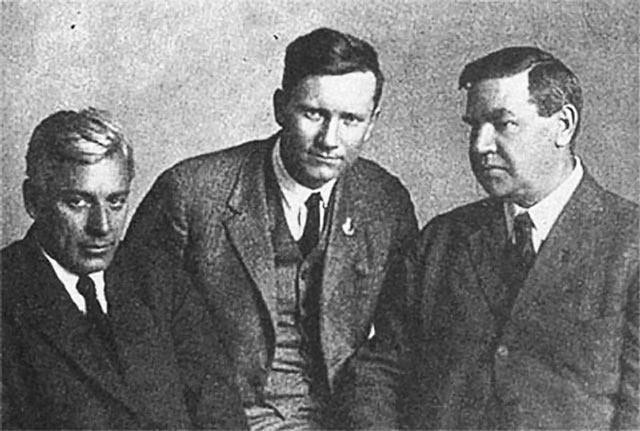
From left: Max Eastman, James P. Cannon and “Big Bill” Haywood in Moscow, 1922.
Back in New York, the left-wing Socialist comrades that Trotsky had established connections with continued the struggle against reformism and opportunism. Following the Bolshevik Revolution, cadres Trotsky had cultivated during his ten-week stay here – Fraina, Boudin, Lore and others – would become founders of the U.S. Communist movement.13 Ackerman rightfully puts much emphasis on this, though his book, while valuable and engaging, includes some errors.
Ackerman at one point mistakenly puts James P. Cannon, the founder of American Trotskyism, in New York in 1917, citing him as one of Trotsky’s direct collaborators at the time. (He mistakes James P. Cannon for a New York Socialist politician named Joseph D. Cannon.) However, the events happening in New York did have an enormous impact on Cannon and other leftists and members of the labor movement of his generation.
Cannon was still in Kansas City then, serving as a roving organizer for the “Wobblies” (the IWW). As Bryan D. Palmer points out in the first volume of his biography of the founder of U.S. Trotskyism, in 1917 Cannon was still an adherent of the IWW’s syndicalist rejection of all “politics.” But Cannon later recalled that NYC workers’ response to the purported antiwar message of Hillquit’s mayoral campaign (though this would prove hollow) left him “shaken up on my anti-political wobblyism.” Moreover, writings by Boudin, Fraina and Lore were introducing many workers to the ideas of Marxism and, after the October Revolution, the views of Lenin and Trotsky and the significance of the Russian Revolution. Palmer points out that Lenin’s “Letter to American Workers” was conveyed through yet another paper edited by Louis Fraina, The Revolutionary Age.
The left-wing radicals Trotsky worked with during his brief stay in New York would later win the majority in the Socialist Party of America. In 1919, the Left Wing Section contended for leadership of the party, advocating affiliation with the Communist International, the world organization of Communist parties founded that year. To prevent the reformists’ ouster from the SP leadership, the faction of Morris Hillquit, Trotsky’s New York nemesis, expelled the majority of the party’s membership – in total, 70,000 of the SP’s 110,000 members. When members of the Left Wing, led by John Reed, sought admission to the SP’s conference in Chicago, Hillquit’s crew called the cops and had them forcibly removed.
Ackerman’s political biases come through in many points throughout the book, making clear his disapproval of Marxism. While rightly pointing to the enormous impact Trotsky’s ten weeks in the New York had on the U.S. left, Ackerman argues ultimately that “Trotsky’s fingerprints are all over the collapse” of American socialism. He believes that time has proven that the ideas of Hillquit have won out, as demonstrated by Bernie Sanders’ popularity. But a politician in a capitalist party who repeatedly votes to fund imperialist wars in no socialist at all.
Among some of his errors and misinterpretations, Ackerman refers to Norman Thomas, the former minister who joined what remained of the SP in 1918 and later became its virulently anti-communist leader, as an opponent of the Vietnam War. In fact, Thomas was a rabid Cold Warrior, self-proclaimed friend of CIA chief Allen Dulles, helped the U.S. government create the puppet state of “South Vietnam” and supported its dictator Diem.14 Ackerman also absurdly swallows the claims by an outfit calling itself the Socialist Equality Party to be inheritors of Trotsky’s legacy. The SEP’s “World Socialist Web Site” has earned the moniker World Scab Web Site for opposing unions, even advocating a “No” vote on unionization at Amazon in Bessemer, Alabama. He also echoes various falsehoods repeated about the early Soviet Republic.
Despite this, in this reviewer’s view, Trotsky in New York still has much of real value for us in our fight for socialist revolution. It gives an important and vivid account of Trotsky’s stay in New York City and the overlooked impact it had on the trajectory of the left. For a popular account by a decidedly bourgeois writer, it is often surprisingly honest in presenting the views and activities of revolutionary Marxists. Its portraits of figures in the socialist movement during the First World War, both the better-known and the obscure, are deeply engaging.
Young revolutionaries can learn a lot from this story about the origins of our movement, which will help inspire many as we continue the struggle against imperialist war and capitalist oppression waged by its protagonists, from New York’s Lower East Side to red Petrograd and beyond, just over a century ago. ■
- 1. This is known as the October Revolution because, according to the old Russian calendar, the seizure of power occurred on 25 October 1917. The date of the New York World headline is 11 November 1917; an exact date has not been found for the Bronx Home News headline, which is cited in Trotsky in New York.
- 2. The New Yorker Volkszeitung (New York People’s Paper) was a German-language daily edited by Ludwig Lore, an influential member of the SP left who became a founder of the Communist movement. Novy Mir (New World) was a Russian-language Marxist magazine published briefly in New York.
- 3. See “International Women’s Day Sparked the 1917 Russian Revolution,” The Internationalist No. 47, March-April 1917.
- 4. See “The Bolshevik Revolution, Leon Trotsky and the New York Public Library,” Revolution No. 14, January 2018.
- 5. Among Trotsky’s important polemics in the period leading up to the revolution was “Pacifism As the Servant of Imperialism” (June 1917). See Lenin’s Socialism and War (1915, published as an Internationalist pamphlet in 2001) for an in-depth explanation of the Marxist position on war and the Bolsheviks’ call for “revolutionary defeatism” to “turn the imperialist war into civil war” on the road to world socialist revolution.
- 6. See the Internationalist pamphlet Marxism and Women’s Revolution (2017).
- 7. Quoted in Tony Michels, “The Russian Revolution in New York, 1917-19,” Journal of Contemporary History, October 2017.
- 8. Several of these figures, together with John Reed, radical journalist Louise Bryant and many others, are portrayed in Warren Beatty’s 1981 film Reds. They also feature in key works on U.S. left history including The Roots of American Communism, by Theodore Draper (1957); The First Ten Years of American Communism: Report of a Participant (1973) by James P. Cannon, the former Industrial Workers of the World activist, socialist and communist leader who became the founder of American Trotskyism in 1928; and Bryan D. Palmer’s thrilling and essential James P. Cannon and the Origins of the American Revolutionary Left, 1890-1928 (2007).
- 9. The IWW (“Wobblies”) of Haywood included such other courageous forerunners of our movement as U.S. labor’s preeminent songwriter, the Swedish immigrant Joe Hill (executed at the behest of the copper bosses in Utah as a result of a frame-up trial in 1915); Elizabeth Gurley Flynn (the “rebel girl” mass agitator who became a founding Communist); black dock workers leader Ben Fletcher; Native American labor organizer Frank Little (lynched in Montana in 1917) and others. On its history, strengths, limitations and post-WWI decline, see Cannon’s “The I.W.W.: The Great Anticipation” (1955).
- 10. Quoted by Ackerman from Sen Katayama, “Morris Hillquit and the Left Wing,” Revolutionary Age, 26 July 1919.
- 11. See James P. Cannon, “Eugene V. Debs: The Socialist Movement of His Time – Its Meaning for Today” (1956); and “Eugene V. Debs vs. Democratic (Party) Socialists of America,” in the Internationalist pamphlet DSA: Fronting for the Democrats (2018).
- 12. The orders are reproduced in Canadian-American Slavic Studies (January 1979).
- 13. In his First Ten Years of American Communism, Cannon states that Fraina should be recognized as the main “founder of the movement,” while calling him “a tragic figure” who, like Lore and Boudin, eventually “renounced his youthful communism.”
- 14. See “The Real Heritage of Harrington’s DSA” and “’Democratic Socialism’ in the Service of U.S. Imperialism” in DSA: Fronting for the Democrats.
